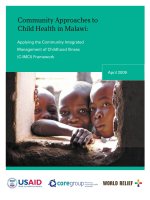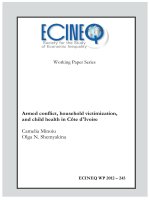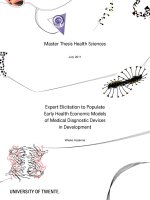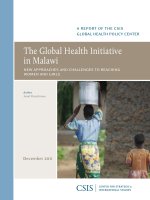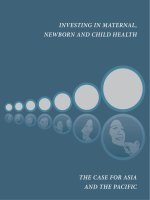Early Inuit Child Health in Canada pdf
Bạn đang xem bản rút gọn của tài liệu. Xem và tải ngay bản đầy đủ của tài liệu tại đây (347.33 KB, 12 trang )
Early Inuit Child Health in Canada
Report 2: Breastfeeding among Inuit in Canada
Sirisha Asuri, PhD*, Anna Claire Ryan
§
and Laura Arbour, MD*
*Department of Medical Genetics, University of British Columbia
Victoria, British Columbia
§
Inuit Tapiriit Kanatami (ITK), Department of Health and Social Development
Ottawa, Ontario
© Copyright 2011. Permission is herewith granted to reproduce this document for educational and health promotion purposes
provided: (1) the document is not sold, (2) no changes are made to the text, and (3) proper attribution is given to the authors
of the document. To obtain permission for uses beyond those outlined above, please contact Dr. Laura Arbour at
and Anna Claire Ryan at
Asuri, Ryan, Arbour 2011
2
INTRODUCTION
Reports have been emerging that suggest Inuit have rates of breastfeeding that are lower than other
Aboriginal populations in Canada, and lower than the national average(1). This is in contrast to
historical reports of early child feeding for Inuit in the Canadian Arctic where it is said that
breastfeeding was the traditional way of feeding an infant and continued for a long time relative to
general Canadian population. A child would usually be weaned when the mother became pregnant with
her next child. On average this was 3 years but it was not uncommon to have children as old as five
years still being breastfed(2). The Inuit Children’s Health report(3) based on the Aboriginal Peoples
Survey (APS) of 2001 and the Indigenous Children's Health Report: Health Assessment in Action(1)
based on the Aboriginal Children’s Survey (ACS) of 2006 both reported breastfeeding initiation for all
Inuit children at 66% compared to 80% for the rest of Canada.
Since breastfeeding has the potential of preventing infant mortality, reducing chronic diseases,
improving immunity, and strengthening maternal-infant bond, exploration of the factors influencing the
breastfeeding practices of Inuit mothers might help inform efforts to increase the rate. This report used
questions from the 2006 Aboriginal Children’s Survey (ACS) to analyze the breastfeeding practices and
the factors that maybe influencing breastfeeding among Inuit mothers.
The 2006 Aboriginal Children’s Survey (ACS) was a post Statistics Canada 2006 - census survey which
provides information on the health, development and well-being of First Nations, Métis and Inuit
children under 6 years of age and living off reserve in urban, rural, and northern locations in Canada.
The number of Inuit children included in the survey was 1, 693 of which there were 459 under one year
of age and 1, 234 who were aged one to five. At the time of the 2006 census there were 7000 Inuit
children under the age of six living throughout Canada. The majority of these children (about 84%)
reside in Inuit Nunangat. Inuit Nunangat is an Inuktitut term used to describe the collective Inuit
homeland comprised of the 4 Inuit land claim regions: Nunatsiavut, Nunavik, Nunavut and the
Inuvialuit Regional Settlement (Figure 1). For the purpose of this report, analyses included only
responses from biological parents of the child in order to better understand the determinants of
breastfeeding for those who are able to breastfeed because the infant lives with them. This is not meant
to disregard the importance of custom adoption for Inuit but rather give context to the breastfeeding
information that was gathered in the Aboriginal Children’s Survey 2006.
Asuri, Ryan, Arbour 2011
3
Figure 1: The four regions of Inuit Nunangat. This map depicts the four Inuit Regions in Canada: The
Inuvialuit Settlement Region in the Northwest Territories, the territory of Nunavut, Nunavik in northern Quebec, and
Nunatsiavut in northern Labrador. Source: Inuit Tapiriit Kanatami (ITK).
BREASTFEEDING
Breastfeeding is important for both infants and mothers. Breast milk is widely recognized as the best
source of nourishment for the baby. Human breast milk is a perfect combination of proteins, lipids,
carbohydrates, vitamins, minerals, enzymes and living cells that meet the nutritional and immunological
requirements of the infant(4, 5). Many essential components for the development of the brain and eye
are found in the right amounts in human milk(6). Breast milk proteins contain necessary immunological
components needed to fight infections when the immature infant gut is highly vulnerable. This becomes
especially important in preterm birth and low birth weight infants in preventing infection(7). Health
Canada states that breastfeeding contributes to the prevention of gastrointestinal tract (GI) infections,
respiratory tract infections, allergies, asthma, Sudden Infant Death Syndrome (SIDS) and also enhances
the cognitive development of the infant(8). The protective effects of breastfeeding against many chronic
diseases such as asthma, dermatitis(9-11), respiratory tract infection(12-16), otitis media(17-19), insulin
dependent diabetes mellitus(20-22), obesity(23-25), cancer(26) have been supported scientifically.
Breastfeeding has been indicated in promoting faster postpartum weight loss for the mother(27), reduce
arthritis risk(28) and reduce risk of breast cancer for the mother(29). Breast cancer mortality for Inuit in
Nunavut is half that of the rest of Canada and is attributed to higher fertility rates and prolonged
breastfeeding in Nunavut(30).
METHODS
To analyze the breastfeeding rates of Inuit infants, questions regarding breastfeeding (Q. D),
demographics of the biological mother (Q. B), birth weight of the infant (Q. C2) from the 2006 ACS
were used (see Appendix 1). This analysis was carried out using a weighted sample representing 3990
Asuri, Ryan, Arbour 2011
4
Inuit infants. Regional differences were analyzed where sufficient data was available. When only limited
sample sets were available responses of Inuit living in Inuit Nunangat and Inuit living outside of Inuit
Nunangat was compared. The rate of breastfeeding initiation was based on any breastfeeding reported in
response to question D1a. The duration of breastfeeding was calculated for 6 months and 12 months
based on the question D1b which asks the length of breastfeeding. Graphpad Instat was used to perform
statistical analysis(31). For comparing two groups of data, unpaired t-test with Welch’s correction was
performed. For groups of more than 3, One-way ANOVA with post tests was performed.
RESULTS
Duration of breastfeeding for Inuit children
The rate of initiation of breastfeeding for all Inuit children aged 1-5 years in Canada surveyed in the
2006 ACS, was 76%. Twenty-four percent of children were never breastfed. Of the infants who were
breastfed, 58% were breastfed for more than 6 months and 36% for more than 12 months [Figure 2].
Although the rates of initiation are lower compared to the national average of 90% (as of 2009),
more Inuit infants are breastfed longer (58% breastfed at 6 months vs. 53% for the rest of
Canada(32)). Only valid responses were included in the analysis.
Figure 2: Duration of Breastfeeding of Inuit children across Canada.
Asuri, Ryan, Arbour 2011
5
Duration of breastfeeding for Inuit children based on area of residence
Prolonged breastfeeding is the traditional norm for Inuit. The support of family and community plays a
role in prolonged breastfeeding. We wondered if Inuit who live outside of Inuit Nunangat and therefore
may lack some of this community support, breastfed for as long as Inuit living in Inuit Nunangat.
As shown in Figure 3, there was no statistically significant difference in the rate of initiation of
breastfeeding between children who reside in Inuit Nunangat or live outside of Inuit Nunangat (p value
0.514); however breastfeeding beyond 6 months and 12 months was significantly higher for infants who
reside in Inuit Nunangat.
In Inuit Nunangat, of those children breastfed, 60% of children were breastfed for more than 6 months
compared to 49% of children living outside of Inuit Nunangat (p < 0.0001). The difference is more
striking for children breastfed for 12 months or more. Of those that were breastfed, 41% of children
living in Inuit Nunangat were breastfed for 12 months or more, compared to 21% living outside of Inuit
Nunangat (p<0.0001). The rates of breastfeeding for 6 months in the general population of Canada are
53% however the rates for 12 months are not available.
Figure 3: Duration of Breastfeeding for Inuit children based on the area of residence.
Asuri, Ryan, Arbour 2011
6
Duration of Breastfeeding in each Inuit Region
Regional differences in breastfeeding rates within the four Inuit regions were charted as shown in Figure
4, in order to understand if regional differences exist. There was a significant difference between the
number of children ever breastfed between Nunavut and Inuvialuit Settlement Region (p<0.05), whereas
no significant differences existed between the other regions. For breastfeeding beyond 6 months,
Nunavik had a lower rate and was significantly different from Nunavut (p<0.001). At 12 months, a
significant difference in breastfeeding was seen between Nunavut and Nunavik (p<0.001) and Nunavut
vs Inuvialiut (p<0.01) with more Nunavut children breastfed longer than 12 months.
Figure 4: The duration of breastfeeding for Inuit children categorized by Inuit region in
Inuit Nunangat.
Duration of breastfeeding based on the birth weight of the infant
The rate of low birth weight infants is higher in Inuit Nunangat compared to the rest of Canada(33). One
of the challenges in caring for the low birth weight infants is initiating and sustaining breastfeeding. Our
analyses wanted to include this important factor to see if low birth weight was a barrier to breastfeeding.
Asuri, Ryan, Arbour 2011
7
Infants who were born below 2500 g (5 lb 8 oz) were considered low birth weight infants in this
analysis. This category includes premature infants, as well as those who were a small size at term.
As shown in Figure 5, at least 47% or maybe higher (sample size restrictions limited our ability to
calculate the maximum rate) of low birth weight babies are never breastfed compared to only 20% of
normal birth weight babies (p<0.0001).
Figure 5: Percentage of never breastfed Inuit children based on birth weight.
DISCUSSION
Inuit breastfeeding practices compared to other populations
Health Canada recommends exclusive breastfeeding for all infants up to 6 months of age followed by
breastfeeding combined with a nutrient rich diet up to 2 years or more(34). Today, more than 90% of
women in the developing world and 50-90% in the industrialized nations initiate breastfeeding but only
35% of them still breastfeed at 4 months of age(35). In Canada, as of 2006, 90% of women initiated
breastfeeding with 53% still breastfeeding at 6 months, but only 14.4% exclusively breastfeeding at 6
months(32, 36, 37). A 2009 report of the analysis of the 2006 Aboriginal Children’s Survey reported
breastfeeding initiation rates in the Aboriginal populations of Canada to be lower than the national
average. The rate of initiation of breastfeeding among Inuit was reported at 66%, although sustained
breastfeeding at 6 months was reported as 54% which is equivalent to the national average(1). That
Asuri, Ryan, Arbour 2011
8
report did not take into consideration the fact that up to 30% of Inuit children are involved in custom
adoption(38), resulting in an underestimation of the breastfeeding rate among infants living with their
biological parents. Similar to what was seen in this analyses, a recent report that took adoption into
consideration suggested an 80% rate of breastfeeding among Inuit living in selected communities of
Nunavut (39).
Factors affecting breastfeeding rates in Inuit
The rate of breastfeeding initiation among Inuit has been reported to be 66% in both 2001(APS) and
2006 (ACS) without any increase. Our analyses does show that this may be an underestimate since
breastfeeding initiation rate of infants in the care of their biological mother is 76% which is closer to
but still less than the national average at 90%. However, the analyses also show that once initiated, Inuit
mothers breastfeed for prolonged periods. The Canada Prenatal Nutrition Program - First Nations and
Inuit Component (CPNP - FNIC) has been operating since 1994 and aims to improve maternal and
infant nutritional health and increase breastfeeding initiation and duration times(40). However, even
with these programs in place, the initiation rate of breastfeeding appears to not have changed since 2001.
There are also regional differences seen such as Inuvialuit Regional Settlement showing a significantly
higher breastfeeding initiation compared to other regions in Inuit Nunangat. Several factors may
contribute to the lower initiation of breastfeeding. Custom adoption is one such factor and remains a
common practice among Inuit communities today. The biological mother often retains a special
relationship with the child and plays an active role in their lives(2). In some situations, the biological
mother breastfeeds the infant but this information was not available in the survey. Mothers residing in
Inuit communities show higher rates of prolonged breastfeeding; therefore community support for
breastfeeding is beneficial. Although not explored in this study, possible deterrents of lower
breastfeeding initiation could include the mother’s apprehensions of the quality of her milk such as for
those who smoke(41) and concerns about environmental contaminants(42-44). Access to support and a
lack of lactation consultants may be another potential issue. If women who want to breastfeed but have a
lot of difficulty, they may not have the support that is needed. Also important to note is that close to
50% of low birth weight babies are never breastfeed. Barriers to breastfeeding the preterm and low birth
weight infants might include separation of infants from mothers, or cultural barriers to breastfeeding
when mothers and infants are transferred to high risk centers. Education, counseling and interventions
have been shown to facilitate the increase of breastfeeding initiation and sustenance in some Aboriginal
communities such as the Sagkeeng First Nation(45). Thus, identifying the needs and providing
appropriate support may help overcome the hurdles in initiation of breastfeeding.
CONCLUSION
The analyses of the 2006 Aboriginal Children’s Survey data on breastfeeding among Inuit demonstrated
positive trends with nearly 76% of Inuit infants being breastfed initially. This is higher than previous
published reports of breastfeeding of Inuit children. Furthermore, a high rate of women continue
breastfeeding for greater than a year. The percentage of Inuit children living in Inuit Nunangat who were
breastfed for more than 12 months was 41%. This is much higher than what is seen in the general
Canadian population. That being said, the rate of breastfeeding initiation among Inuit has been found to
Asuri, Ryan, Arbour 2011
9
be comparatively lower and thus warrants the need to address barriers to initiation of breastfeeding.
More health promotion programs which are culturally and linguistically appropriate for Inuit available
throughout Inuit Nunangat may help.
LIMITATIONS
• Data used for the analyses is based on the data from the ACS 2006 which is a nationwide
survey and hence include certain limitations. Although technical advisory groups consisting
of aboriginal advisors, parents, early childhood educators were involved in the design of the
survey the questions may be understood differently by people answering them.
• Although the questions were all translated into Aboriginal languages and Aboriginal
interviewers were used for the most part, there is a possibility of communication barriers and
cultural misunderstandings.
• The data is based on the answers provided by parents retrospectively. The time of interview
is not necessarily the time during which the child was breastfed; hence the answers are based
on the recollection by the parents of information that was a few months to 5 years old.
• Also, the place of residence of the mother/child at the time of breastfeeding may not be
similar to their place of residence when the child was being breastfed, hence the comparison
of breastfeeding rates for those living in Inuit Nunangat vs. outside of Inuit Nunangat have to
be taken with that caveat.
Asuri, Ryan, Arbour 2011
10
REFERENCES
1. Smylie J. Indigenous Children's Health Report: Health Assesment in Action. Available:
(Accessed April 2011) 2009.
2. Pauktuutit Inuit Women of Canada, The Inuit Way: A guide to Inuit Culture, 2006.
3. Inuit Children's Health: A Report Using the 2001 Aboriginal Peoples Survey (Children and Youth
Component). Available:
(Accessed
September 2010).
4. Kunz C, Rodriguez-Palmero M, Koletzko B, Jensen R. Nutritional and biochemical properties of human
milk, Part I: General aspects, proteins, and carbohydrates. Clin Perinatol. 1999 Jun;26(2):307-33.
5. do Nascimento MB, Issler H. Breastfeeding: making the difference in the development, health and
nutrition of term and preterm newborns. Rev Hosp Clin Fac Med Sao Paulo. 2003 Jan-Feb;58(1):49-60.
6. Newton ER. Breastmilk: the gold standard. Clin Obstet Gynecol. 2004 Sep;47(3):632-42.
7. Hylander MA, Strobino DM, Dhanireddy R. Human milk feedings and infection among very low birth
weight infants. Pediatrics. 1998 Sep;102(3):E38.
8. Canadian Paediatric Society, Dietitians of Canada and Health Canada. Nutrition for Healthy Term Infants,
Minister of Public Works and Government Services, Ottawa, 2005. Available:
/>an/pubs/infant-nourrisson/nut_infant_nourrisson_term-eng.php (Accessed April 2010).
9. Duncan JM, Sears MR. Breastfeeding and allergies: time for a change in paradigm? Curr Opin Allergy Clin
Immunol. 2008 Oct;8(5):398-405.
10. Miyake Y, Tanaka K, Sasaki S, Kiyohara C, Ohya Y, Fukushima W, et al. Breastfeeding and the risk of
wheeze and asthma in Japanese infants: the Osaka Maternal and Child Health Study. Pediatr Allergy Immunol.
2008 Sep;19(6):490-6.
11. Kramer MS, Matush L, Vanilovich I, Platt R, Bogdanovich N, Sevkovskaya Z, et al. Effect of prolonged and
exclusive breast feeding on risk of allergy and asthma: cluster randomised trial. BMJ. 2007 Oct
20;335(7624):815.
12. Bilenko N, Ghosh R, Levy A, Deckelbaum RJ, Fraser D. Partial breastfeeding protects Bedouin infants
from infection and morbidity: prospective cohort study. Asia Pac J Clin Nutr. 2008;17(2):243-9.
13. Majeed R, Rajar UD, Shaikh N, Majeed F, Arain AA. Risk factors associated with childhood asthma. J Coll
Physicians Surg Pak. 2008 May;18(5):299-302.
14. Bener A, Ehlayel MS, Alsowaidi S, Sabbah A. Role of breast feeding in primary prevention of asthma and
allergic diseases in a traditional society. Eur Ann Allergy Clin Immunol. 2007 Dec;39(10):337-43.
15. Oddy WH. Breastfeeding and asthma in children. A prospective cohort study. Adv Exp Med Biol.
2000;478:393-4.
16. Chantry CJ, Howard CR, Auinger P. Full breastfeeding duration and associated decrease in respiratory
tract infection in US children. Pediatrics. 2006 Feb;117(2):425-32.
17. Vogazianos E, Vogazianos P, Fiala J, Janecek D, Slapak I. The effect of breastfeeding and its duration on
acute otitis media in children in Brno, Czech Republic. Cent Eur J Public Health. 2007 Dec;15(4):143-6.
18. Patel JA, Nair S, Revai K, Grady J, Saeed K, Matalon R, et al. Association of proinflammatory cytokine
gene polymorphisms with susceptibility to otitis media. Pediatrics. 2006 Dec;118(6):2273-9.
19. Wiertsema SP, Leach AJ. Theories of otitis media pathogenesis, with a focus on Indigenous children.
Med J Aust. 2009 Nov 2;191(9 Suppl):S50-4.
20. Pettitt DJ, Forman MR, Hanson RL, Knowler WC, Bennett PH. Breastfeeding and incidence of non-insulin-
dependent diabetes mellitus in Pima Indians. Lancet. 1997 Jul 19;350(9072):166-8.
21. Young TK, Martens PJ, Taback SP, Sellers EA, Dean HJ, Cheang M, et al. Type 2 diabetes mellitus in
children: prenatal and early infancy risk factors among native canadians. Arch Pediatr Adolesc Med. 2002
Jul;156(7):651-5.
22. Rapid early growth is associated with increased risk of childhood type 1 diabetes in various European
populations. Diabetes Care. 2002 Oct;25(10):1755-60.
Asuri, Ryan, Arbour 2011
11
23. Owen CG, Martin RM, Whincup PH, Smith GD, Cook DG. Effect of infant feeding on the risk of obesity
across the life course: a quantitative review of published evidence. Pediatrics. 2005 May;115(5):1367-77.
24. Savino F, Liguori SA, Fissore MF, Oggero R. Breast milk hormones and their protective effect on obesity.
Int J Pediatr Endocrinol. 2009;2009:327505.
25. Palou A, Sanchez J, Pico C. Nutrient-gene interactions in early life programming: leptin in breast milk
prevents obesity later on in life. Adv Exp Med Biol. 2009;646:95-104.
26. Martin RM, Gunnell D, Owen CG, Smith GD. Breast-feeding and childhood cancer: A systematic review
with metaanalysis. Int J Cancer. 2005 Dec 20;117(6):1020-31.
27. Kramer MS, Kakuma R. The optimal duration of exclusive breastfeeding: a systematic review. Adv Exp
Med Biol. 2004;554:63-77.
28. Karlson EW, Mandl LA, Hankinson SE, Grodstein F. Do breast-feeding and other reproductive factors
influence future risk of rheumatoid arthritis? Results from the Nurses' Health Study. Arthritis Rheum. 2004
Nov;50(11):3458-67.
29. Martin RM, Middleton N, Gunnell D, Owen CG, Smith GD. Breast-feeding and cancer: the Boyd Orr
cohort and a systematic review with meta-analysis. J Natl Cancer Inst. 2005 Oct 5;97(19):1446-57.
30. Nunavut Department of Health and Social Service. Report on Comparable Health Indicators for Nunavut
and Canada. September 2002. Available:
(Accessed August
2010).
31. GraphPad InStat version 3.05 for Windows 95, GraphPad Software, San Diego California USA,
www.graphpad.com.
32. Al-Sahab B, Lanes A, Feldman M, Tamim H. Prevalence and predictors of 6-month exclusive
breastfeeding among Canadian women: a national survey. BMC Pediatr. Apr 8;10(1):20.
33. Luo ZC, Senecal S, Simonet F, Guimond E, Penney C, Wilkins R. Birth outcomes in the Inuit-inhabited
areas of Canada. CMAJ. Feb 23;182(3):235-42.
34. Exclusive Breastfeeding Duration. 2004 Health Canada Recommendation. Available:
-
sc.gc.ca/fn-an/alt_formats/hpfb-dgpsa/pdf/nutrition/excl_bf_dur-dur_am_excl-eng.pdf (Acessed April 2010).
35. Heird WC. Progress in promoting breast-feeding, combating malnutrition, and composition and use of
infant formula, 1981-2006. J Nutr. 2007 Feb;137(2):499S-502S.
36. Public Health Agency of Canada. Canadian Perinatal Health Report, 2008. Available:
c-
aspc.gc.ca/publicat/2008/cphr-rspc/pdf/cphr-rspc08-eng.pdf (Accessed April 2010).
37. Chalmers B, Levitt C, Heaman M, O'Brien B, Sauve R, Kaczorowski J. Breastfeeding rates and hospital
breastfeeding practices in Canada: a national survey of women. Birth. 2009 Jun;36(2):122-32.
38. Billson J, Kyra M. Inuit women: their powerful spirit in a century of change. p266. 2007.
39. Egeland GM, Faraj N, Osborne G. Cultural, socioeconomic, and health indicators among Inuit
preschoolers: Nunavut Inuit Child Health Survey, 2007-2008. Rural Remote Health. 2010 Apr-Jun;10(2):1365.
40. Canada Prenatal Nutrition Program - First Nations and Inuit Component (CPNP - FNIC). Available:
(Accessed September 2010)
41. Dorea JG. Maternal smoking and infant feeding: breastfeeding is better and safer. Matern Child Health J.
2007 May;11(3):287-91.
42. Dewailly E, Ayotte P, Bruneau S, Laliberte C, Muir DC, Norstrom RJ. Inuit exposure to organochlorines
through the aquatic food chain in arctic quebec. Environ Health Perspect. 1993 Dec;101(7):618-20.
43. Ayotte P, Carrier G, Dewailly E. Health risk assessment for inuit newborns exposed to dioxin-like
compounds through breast feeding. Chemosphere. 1996 Feb;32(3):531-42.
44. Jorissen J. Literature review. Outcomes associated with postnatal exposure to polychlorinated biphenyls
(PCBs) via breast milk. Adv Neonatal Care. 2007 Oct;7(5):230-7.
45. Martens PJ. Increasing breastfeeding initiation and duration at a community level: an evaluation of
Sagkeeng First Nation's community health nurse and peer counselor programs. J Hum Lact. 2002 Aug;18(3):236-
46.
Asuri, Ryan, Arbour 2011
12
APPENDIX I
Q.no
ACS Section
Question
B
Household
rooster
The next section is about the people who currently live in your home. Starting with
you could you give me the first name, date of birth, age, sex and marital status of all
the people living in your home and their relationship to _______?
C2
Child’s
Health
How much did __________ weigh at birth
(Interviewer: Accept respondents best estimate.)
_ _ Pounds _ _Ounces Or _ _ _ _ Grams
1. Don’t know 2. Refused
D1
Food and
Nutrition
a. Was____ ever breastfed?
1. Yes 2. No 3. Don’t know 4. Refused
b. For how long?
_ _ Months Or _ _ Years
1. Less than a month 2. Don’t know 3. refused



